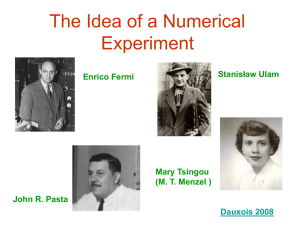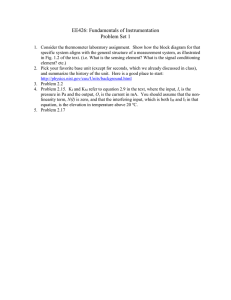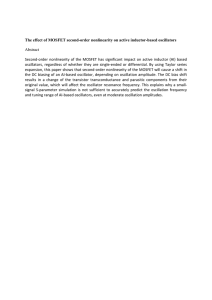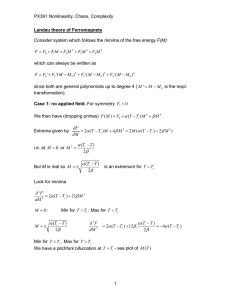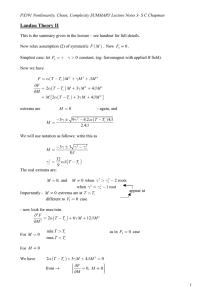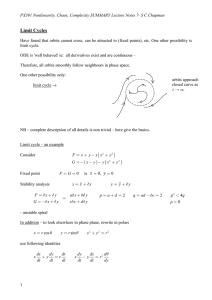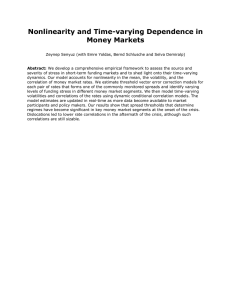On The Nonlinearity of Maximum
advertisement
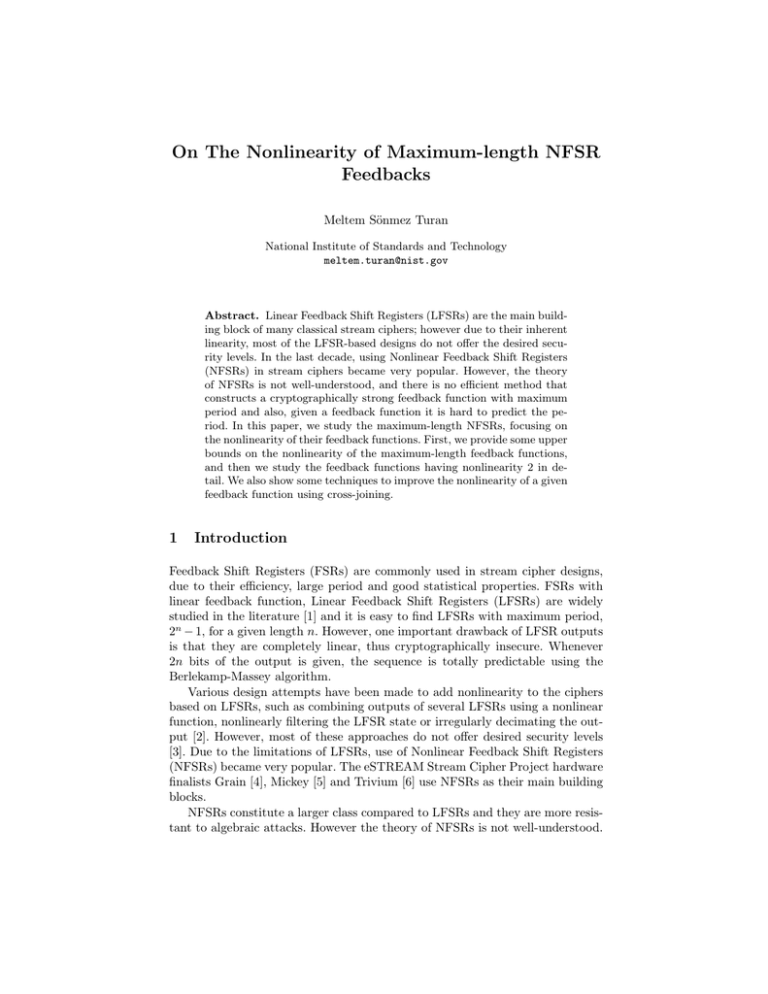
On The Nonlinearity of Maximum-length NFSR
Feedbacks
Meltem Sönmez Turan
National Institute of Standards and Technology
meltem.turan@nist.gov
Abstract. Linear Feedback Shift Registers (LFSRs) are the main building block of many classical stream ciphers; however due to their inherent
linearity, most of the LFSR-based designs do not offer the desired security levels. In the last decade, using Nonlinear Feedback Shift Registers
(NFSRs) in stream ciphers became very popular. However, the theory
of NFSRs is not well-understood, and there is no efficient method that
constructs a cryptographically strong feedback function with maximum
period and also, given a feedback function it is hard to predict the period. In this paper, we study the maximum-length NFSRs, focusing on
the nonlinearity of their feedback functions. First, we provide some upper
bounds on the nonlinearity of the maximum-length feedback functions,
and then we study the feedback functions having nonlinearity 2 in detail. We also show some techniques to improve the nonlinearity of a given
feedback function using cross-joining.
1
Introduction
Feedback Shift Registers (FSRs) are commonly used in stream cipher designs,
due to their efficiency, large period and good statistical properties. FSRs with
linear feedback function, Linear Feedback Shift Registers (LFSRs) are widely
studied in the literature [1] and it is easy to find LFSRs with maximum period,
2n − 1, for a given length n. However, one important drawback of LFSR outputs
is that they are completely linear, thus cryptographically insecure. Whenever
2n bits of the output is given, the sequence is totally predictable using the
Berlekamp-Massey algorithm.
Various design attempts have been made to add nonlinearity to the ciphers
based on LFSRs, such as combining outputs of several LFSRs using a nonlinear
function, nonlinearly filtering the LFSR state or irregularly decimating the output [2]. However, most of these approaches do not offer desired security levels
[3]. Due to the limitations of LFSRs, use of Nonlinear Feedback Shift Registers
(NFSRs) became very popular. The eSTREAM Stream Cipher Project hardware
finalists Grain [4], Mickey [5] and Trivium [6] use NFSRs as their main building
blocks.
NFSRs constitute a larger class compared to LFSRs and they are more resistant to algebraic attacks. However the theory of NFSRs is not well-understood.
There is no efficient method that finds a cryptographically strong feedback function with maximum period 2n for a given n and also, given a feedback function
it is hard to predict the period.
Golomb presented a method to construct maximum-length NFSRs using
primitive polynomials [1] (p. 115), however, these feedback functions have very
low nonlinearity which allows them to be approximated using affine functions.
Also, in 1982, Fredricksen [7] presented a survey on maximum-length NFSRs
including construction methods and some properties. Tsueda et al. [8] proposed
feedback-limited NFSRs and studied their properties in terms of correlation and
linear complexity measures. Çalık et al. [9] studied maximum-length NFSRs focusing on the number of monomials.
In this paper, we study the nonlinearity of the feedback functions that generate maximum-length sequences. First, we provide some upper bounds on the
nonlinearity of the feedback functions, and then we study the feedback functions
having nonlinearity 2 in detail. We also show some techniques to increase the
nonlinearity of a given feedback function using cross-joining and present some results on the relation between number of monomials and nonlinearity for extreme
cases.
The paper is organized as follows. In Section 2, we give a brief introduction
to Boolean functions and FSRs. The properties of maximum-length NFSRs are
provided in Section 3. Section 4 focuses on the nonlinearity of feedback functions.
Section 5 concludes the paper.
2
2.1
Preliminaries
Boolean Functions
A Boolean function f with n variables is a mapping from F2n to F2 . Let αi
be the n-bit vector corresponding to the binary representation of integers i =
0, 1, 2, . . . , 2n − 1. For a Boolean function with n variables, the sequence
(f (α0 ), f (α1 ), . . . , f (α2n −1 ))
(1)
is called the truth table of f . Algebraic normal form (ANF) of a Boolean function
is the polynomial
f (x1 , x2 , . . . , xn ) = c0 ⊕ c1 x1 ⊕ . . . ⊕ c12...n x1 x2 . . . xn
(2)
with ci1 ...ik ’s in F2 . The highest number of terms in a monomial with nonzero
coefficient is called the degree of f . The Boolean functions with degree 1 are
called affine and in particular for c0 = 0, the functions are called linear.
The distance between two Boolean functions f and g is defined as the number
of different entries in their truth table and denoted by d(f, g), i.e., the weight of
f ⊕ g. Walsh transform of f is defined to be
X
Wf (α) =
(−1)f (x)⊕α.x .
x∈F2n
Nonlinearity of a Boolean function f , denoted as N l(f ) is the minimum distance
of f to the set of all affine functions, which is
2n−1 −
1
max{|Wf (α)|}.
2 α
(3)
Nonlinearity of a Boolean function is bounded by 2n−1 −2n/2−1 . The Boolean
functions with even number of variables that achieve this bound are called bent
functions. Weight of bent functions can take two values 2n−1 ± 2n/2−1 , i.e., they
are not balanced, thus not very useful in cryptographic applications.
Two n-bit Boolean functions f (x) and h(x) are called affine equivalent, if
h(x) = f (Ax + b), where A is an n by n binary non-singular matrix and b is an
n-bit binary vector and it is known that N l(f ) and N l(h) are equal.
2.2
Feedback Shift Registers
A FSR is a device that shifts its contents into adjacent positions within the
register and fills the position on the other end with a new value generated by
the feedback function. The individual delay cells of the register are called the
stages and the number of the stages n is called the length of FSR. The contents
of the n stages are called the state of the FSR. The n bit vector (s0 , s1 , . . . , sn−1 )
initially loaded into FSR state specify the initial state. A block diagram of a FSR
is given in Figure 1.
Fig. 1. Block diagram of a Feedback Shift Register.
A FSR is uniquely determined by its length n and n variable Boolean feedback
function f (x1 , x2 , . . . , xn ). The output sequence S= {s0 , s1 , s2 , . . .} of a FSR
satisfy the following recursion
sn+i = f (si , . . . , sn−1+i ), i ≥ 0
(4)
given the initial state (s0 , s1 , . . . , sn−1 ).
For LFSRs, this recursion is linear and may be represented using the characteristic polynomial,
n
X
C(x) =
ci xn−i
(5)
i=0
with c0 = 1. If C(x) is a primitive polynomial with degree n, then each of the
2n − 1 non-zero initial states of the LFSR produce an output with maximum
possible period 2n − 1. Outputs of maximum-length LFSRs are called maximal
length sequences or m-sequences.
Let Ln be the set of all linear feedback functions that generate m-sequence.
The number of primitive polynomial of degree n over F2 is given by φ(2n − 1)/n,
where φ(n) is the Euler’s phi function, hence
|Ln | = φ(2n − 1)/n.
(6)
For NFSRs, the output sequences can achieve the period of 2n . Such sequences include each n-bit pattern exactly once and are called de Bruijn sequences. Let Dn be the set of all feedback functions that generate de Bruijn
sequence and
n−1
(7)
|Dn | = 22 −n [10].
3
3.1
NFSRs and de Bruijn Sequences
Properties of Maximum-Length NFSRs
In this part of the study, we survey some of the necessary conditions of the
feedback function f (x1 , . . . , xn ) to generate de Bruijn sequences.
To guarantee that every state has a unique predecessor and successor, f
should be written in the form f (x1 , . . . , xn ) = x1 + g(x2 , . . . , xn ) [1]. Some necessary conditions on f and g to generate a de Bruijn sequence are given as
follows;
1. To avoid all zero cycle, f (0, . . . , 0) = 1, i.e. c0 = 1. Due to unique predecessor
and successor property, f (1, 0, . . . , 0) = 0.
2. To avoid all one cycle, f (1, . . . , 1) = 0, therefore the number of monomials in
f is even. Due to unique predecessor and successor property, f (0, 1, . . . , 1) =
1.
3. To avoid the cycle (00 . . . 01), there exists a coefficient ci = 0, for i = 2, . . . , n
[11].
4. The parity of the cycles generated by a FSR is equal to the parity of the
truth table of g [1]. To achieve one maximum-length cycle, parity of the truth
table of g should be 1, which implies c23...n = 1.
5. The weight w(g) of g satisfies the following inequality
Zn−1 ≤ w(g) ≤ 2n−1 − Zn∗ + 1
(8)
P
P
1
φ(2d)2n/2d with summawhere Zn is n1 d|n φ(d)2n/d and Zn∗ is Z2n − 2n
tion over all even divisors of n [7].
6. Let f = x1 + g(x2 , . . . , xn ) generate a de Bruijn sequence and n > 2. Then,
g(x2 , . . . , xn ) 6= g(xn , . . . , x2 ),
i.e., g is not rotation symmetric [9].
(9)
4
On The Nonlinearity of Feedback Functions
In this part of the paper, we study on the nonlinearity of the feedback functions
that generate de Bruijn sequences.
Proposition 1. Let f (x1 , . . . , xn ) ∈ Dn . The nonlinearity of f satisfies
N l(f ) ≡ 2 (mod 4).
Proof. Due to the unique predecessor and successor property, f has the form;
f = x1 + g. For any linear function l, g ⊕ l includes the monomial x2 · · · xn ,
therefore weight of g ⊕ l is always odd. This guarantees that nonlinearity of g
is odd. Let N l(g) = 2k + 1, then N l(f ) = 2(2k + 1) = 4k + 2, hence N l(f ) ≡
2 (mod 4).
Next, we show some upper bounds on the nonlinearity of f ∈ Dn . As mentioned in Section 2, nonlinearity of an n-variable Boolean function is bounded
by 2n−1 − 2n/2−1 . Since the functions achieving this bound are not balanced,
they cannot generate de Bruijn sequences. Next proposition provides an upper
bound on the nonlinearity of f ∈ Dn based on the weight of g, w(g).
Proposition 2. The nonlinearity of f ∈ Dn is bounded by
N l(f ) ≤ min{2n − 2Zn∗ + 2, 2n − 2Zn−1 }.
Proof. According to [7], the weight of g satisfies the following inequality
Zn−1 ≤ w(g) ≤ 2n−1 − Zn∗ + 1.
Since the distance between g and the constant zero function is w(g), N l(g) ≤
w(g) and N l(f ) ≤ 2w(g). Then
N l(f ) ≤ 2n − 2Zn∗ + 2
(10)
is satisfied. Similarly, the distance between g and the constant one function is
equal to 2n−1 − w(g). Then,
N l(f ) ≤ 2n − 2Zn−1
(11)
is satisfied. Combining (10) and (11), nonlinearity of f is bounded by
N l(f ) ≤ min{2n − 2Zn∗ + 2, 2n − 2Zn−1 }.
It should be noted these bounds are not tight, as they are only based on the
weight of g, not on the location of 1’s in the truth table of g. Another bound for
the nonlinearity of f is provided in the next proposition.
Proposition 3. The nonlinearity of f ∈ Dn is bounded by
2n−1 − 2(n−1)/2 ,
for n > 2.
Proof. The nonlinearity of the (n-1)-variable Boolean function g is bounded by
2(n−2) −2(n−3)/2 . It is known that for n > 2, degree of an n-variable bent function
is bounded by n/2. Since the degree of g is n − 1, this bound cannot be achieved
by g. Therefore, the following is satisfied;
N l(f ) < 2(2(n−2) − 2(n−3)/2 )
< 2n−1 − 2(n−1)/2 .
Table 1 shows two upper bounds on the nonlinearity of f . The first bound is
the generic nonlinearity bound for Boolean functions, whereas the second bound
is obtained using Proposition 1 and 3.
n Bound 1 Bound 2
5
13
10
6
28
26
7
58
54
8
120
114
9
244
238
10
496
486
Table 1. Nonlinearity bounds on the N l(f ).
Let γn (c) denote the number of n-variable maximum-length feedback funcP
2n−1 −n
tions with nonlinearity c. Trivially,
. The value of γn (c)
c γn (c) = 2
for arbitrary n and c is not known. According to the Proposition 1, γn (4k) =
γn (4k + 1) = γn (4k + 3) = 0, k ≥ 0. Table 2 shows the distribution of γn (c) for
n = 5, 6.
Proposition 4. γn (c) ≡ 0 (mod 4), for even n ≥ 3.
Proof. The complement cS and the reverse rS of a de Bruijn sequence S =
{s0 , s1 , . . . , s2n −1 } is defined to be cS = {s00 , s01 , . . . , s02n −1 } where s0i is the binary complement of si and rS = {s2n −1 , . . . , s1 , s0 }. Let f (x1 , x2 , . . . , xn ) ∈
Dn generate S, then f (x1 , x02 , . . . , x0n ) generates cS and f (x1 , xn , xn−1 , . . . , x2 )
generates rS [7]. Since f (x1 , . . . , xn ), f (x1 , x02 , . . . , x0n ), f (x1 , xn , . . . , x2 ) and
f (x1 , x0n , x0n−1 , . . . , x02 ) are affine equivalent, the nonlinearity of feedback functions generating S, rS, cS and rsS are equal. In [12], it is shown that S, rS, cS
and rsS are distinct sequences, for even n. Hence, γn (c) ≡ 0 (mod 4) for even
n ≥ 3.
4.1
Feedback Functions with Nonlinearity 2
As shown in Proposition 1, the minimum value of the nonlinearity of a maximumlength feedback function is 2. Following proposition shows a construction method
of feedback functions having nonlinearity 2 using primitive polynomials.
n c
2
γn (c)
24
5 6
1128
10
896
2
32
6
7408
6
10 352,752
14 6,491,072
18 42,601,512
22 17,656,088
Table 2. The distribution of γn (c) for n = 5, 6.
Proposition 5. Let F = c1 xn +c2 xn−1 +. . .+cn x+1 be a primitive polynomial
with degree n over the finite field GF(2).
(i) f1 (x1 , . . . , xn ) = c1 x1 +c2 x2 +. . .+cn xn +x02 x03 · · · x0n ∈ Dn [1] and N l(f1 ) =
2.
(ii) f2 (x1 , . . . , xn ) = 1 + c1 x1 + c2 x2 + . . . + cn xn + x2 x3 · · · xn ∈ Dn [9] and
N l(f2 ) = 2.
Proof. Given a primitive polynomial F (x), it is known that l(x) = c1 x1 + . . . +
cn xn generates a state diagram with two cycles, one of which is the all-zero cycle
and the other is a cycle of length 2n − 1.
(i) These two cycles can be combined by adding x02 x03 · · · x0n to l(x), which is
equivalent to changing the the truth table entries corresponding to (10 . . . 0)
and (00 . . . 0) [1]. Then, f1 (x1 , . . . , xn ) = l(x) + x02 x03 · · · x0n generates a cycle with length 2n and since only two truth table entries of l are changed,
N l(f1 ) = 2.
(ii) Since F (x) is primitive, the number of monomials in F (x), also in l(x), is
odd, so l0 (x) = c1 x01 + . . . + cn x0n = 1 + c1 x1 + c2 x2 + . . . + cn xn . l0 (x)
generates two cycles one of which is the all-one cycle and the other one is
the cycle of length 2n − 1, which are the complements of the cycles generated
by l(x). These two cycles are combined by adding x2 x3 · · · xn to f (x), which
is equivalent to changing the truth table entries corresponding to (011 . . . 1)
and (11 . . . 1), therefore N l(f2 ) = 2.
Table 3 lists 12 feedback functions generated using the primitive polynomials,
for n = 5. There exists other feedback functions with nonlinearity 2 which can be
constructed using affine functions having two cycles, where length of the shortest
cycle is greater than 1. These functions are highlighted in Table 4.1. These cycles
can also be combined in various ways to generate feedback functions having
nonlinearity 2, as given in the next example.
Primitive polynomial Feedback Functions with Nonlinearity 2
1 + x2 + x5
x1 + x4 + x02 x03 x04 x05
1 + x1 + x4 + x2 x3 x4 x5
1 + x + x2 + x3 + x5
x1 + x3 + x4 + x5 + x02 x03 x04 x05
1 + x3 + x5
x1 + x3 + x02 x03 x04 x05
1 + x + x3 + x4 + x5
1 + x2 + x3 + x4 + x5
1 + x + x2 + x4 + x5
1 + x1 + x3 + x4 + x5 + x2 x3 x4 x5
1 + x1 + x3 + x2 x3 x4 x5
x1 + x2 + x3 + x5 + x02 x03 x04 x05
1 + x1 + x2 + x3 + x5 + x2 x3 x4 x5
x1 + x2 + x3 + x4 + x02 x03 x04 x05
1 + x1 + x2 + x3 + x4 + x2 x3 x4 x5
x1 + x2 + x4 + x5 + x02 x03 x04 x05
1 + x1 + x2 + x4 + x5 + x2 x3 x4 x5
Table 3. Construction of f with nonlinearity 2, for n=5, using primitive polynomials.
Example 1. The cycle decomposition of affine function f = 1 + x1 + x3 + x5
includes two cycles; (000001011011100111110100100011) and (01). The long cycle includes all n-bit patterns except (10101) and (01010). The (01) pattern is
embedded to the long cycle such that the new generated cycle includes all n-bit
patterns and it can be done in two ways as shown in the following figure.
New sequence
Feedback function
(00000101011011100111110100100011) f + (x3 + x5 ) x02 x04
(00001011011100111110101001000110) f + (x2 + x4 ) x03 x05
Table 4. Combining the two cycles of f = 1 + x1 + x3 + x5
Proposition 6. The number of maximum-length feedback functions with nonlinearity 2 satisfies
φ(2n − 1)
2
≤ γn (2) ≤ 22n ,
(12)
n
where φ(n) is the Euler’s phi function.
Proof. Proposition 5 provides a method to construct two distinct feedback functions with nonlinearity 2 using a primitive polynomial of degree n. Therefore,
Affine function
Cycle decomposition
# cycles
1 + x1 + x2 + x3 + x5
(0000010111011010100111100011001) (1)
2
1 + x1 + x2 + x3 + x4
(0000011011001111010010101110001) (1)
2
1 + x1 + x4
(0000011001011011110101000100111) (1)
2
1 + x1 + x3
(0000011100100010101111011010011) (1)
2
1 + x1 + x3 + x4 + x5
(0000010001110101001011110011011) (1)
2
1 + x1 + x2 + x4 + x5
(0000010011000111100101011011101) (1)
2
1 + x1 + x3 + x5
(000001011011100111110100100011) (01)
2
1 + x1 + x2 + x4
(000001100010010111110011101101) (01)
2
1 + x1 + x2 + x3
(0000011101011011111000101001) (0011)
2
1 + x1 + x4 + x5
(0000010010100011111011010111) (0011)
2
1 + x1
(0000011111) (0001011101) (0010011011) (01)
4
1 + x1 + x5
(000001010110011101111) (0001101) (001) (1)
4
1 + x1 + x3 + x4
(000001101011) (0001) (001010011111) (0111)
4
1 + x1 + x2
(000001111011100110101) (0001011) (001) (1)
4
1 + x1 + x2 + x5
(00000101) (00011011) (00100111) (01011111)
4
1 + x1 + x2 + x3 + x4 + x5 (000001) (000111) (001011) (001101) (01) (011111) 6
Table 5. Cycle decompositions of affine functions with c0 = 1, for n=5.
γn (2) is lower bounded by 2 times the number of primitive polynomials, which is
n
equal to 2 φ(2 n−1) .
The number of Boolean functions having nonlinearity 2 is calculated by countingn the number of 2 possible changes to all affine functions and is equal to
2
n+1
. For the functions in Dn , the changes should be symmetric, in other
2 2
words, f (a1 , a2 , . . . , an ) and f (a1 + 1, a2 , . . . , an ) should be changed simultaneously. Therefore, the number of feedback functions with nonlinearity 2 is upper
n−1 bounded by 2 1 2n+1 = 22n .
Proposition 7. The number of maximum-length feedback functions with nonlinearity t is bounded by
n−1 2
γn (t) ≤
2n+1 ,
(13)
t/2
for even t < 2n−2 .
Proof. The number of functions having nonlinearity t is calculated by counting
n
the number of t possible changes to all affine functions and is equal to 2t 2n+1 ,
for t < 2n−2 [13]. Since the changes should be symmetric, the total number of
n−1
changes that can be given to an affine function is bounded by 2 t/2−2 .
4.2
Cross-joining to Increase Nonlinearity
Cross-joining is a well-known method to construct maximum-length feedback
functions given another feedback function [7]. Given f ∈ Dn , the method first
flips one position of the truth table of g, this splits the output of f into two
cycles. Then, if a second position in the truth table of g exists, such that flipping
it combines the two cycles to produce a new cycle of length 2n , then this pair of
positions is called a cross-join pair.
In the previous section, construction of feedback functions with nonlinearity
2 is described. By cross-joining, the nonlinearity of the feedback functions can
be improved. Cross-joining flips four positions of the truth tables, therefore the
nonlinearity of the newly constructed feedback function is bounded by N l(f )+4.
Helleseth and Kløve [14] proved that the number of cross-join pairs in an n-bit
maximum-length LFSR is (2n−1 − 1)(2n−1 − 2)/6.
Cross-joining is also equivalent to dividing a de Bruijn sequence into five
parts and permuting the parts as given in Figure 2. The permutation basically
interchanges the positions of the part II and part IV . It is possible to verify
that the sequence generated by interchanging the positions of the unique runs
of n and n − 2 zeros in a de Bruijn sequence, is also a de Bruijn sequence. This
is also true for interchanging the unique runs of n and n − 2 ones [12].
(← I → || ← II → || ← III → || ← IV → || ← V →)
⇐⇒
(← I → || ← IV → || ← III → || ← II → || ← V →)
Fig. 2. Cross join pair effect on de Bruijn sequence
Proposition 8. If f (x1 , . . . , xn ) ∈ Dn , then f1 = f ⊕ (x2 ⊕ xn )x03 x04 . . . x0n−1
and f2 = f ⊕ (x2 ⊕ xn )x3 x4 . . . xn−1 ∈ Dn .
Proof. The monomial (x2 ⊕ xn )x03 x04 . . . x0n−1 takes the value 1 in four positions of the truth table of f , i.e. flips the output of f in the following inputs;
f (0, 1, 0, . . . , 0), f (1, 1, 0, . . . , 0), f (0, . . . , 0, 1), f (1, 0, . . . , 0, 1). These changes
results in interchanging the runs of n and n − 2 zeros. Similarly, adding (x2 ⊕
xn )x3 x4 . . . xn−1 , changes the following outputs of f ; f (0, 1, . . . , 1, 0), f (1, 1, . . . , 1, 0),
f (0, 0, 1 . . . , 1), f (1, 0, 1, . . . , 1). These changes results in interchanging the runs
of n and n − 2 ones. Therefore, f1 and f2 also generate de Bruijn sequences.
Given a feedback function with nonlinearity 2, applying the changes given in
Proposition 8 increases the nonlinearity to 6. Independent cross-join pairs may
be applied to further increase the nonlinearity of the feedback function.
4.3
Number of Monomials
Hardware efficiency of NFSRs is extremely important, especially for stream ciphers designed for restricted environments. In general, the feedback functions
with less number of monomials are implemented more efficiently in hardware
and these functions are of interest. Çalık et al. [9] studied the number of monomials in the maximum-length feedback functions and showed that it is at least
4.
Proposition 9. Let f ∈ Dn be a 4-monomial feedback function.
N l(f ) ≤
2n
.
n−1
Proof. 4-monomial feedback functions are of the form;
f (x1 , x2 , . . . , xn ) = 1 + x1 + x2 · · · xn + h(x2 , . . . , xn ),
where the degree of h(x) is upper bounded by log2 n [9]. Nonlinearity of f is equal
to 2N l(h(x) + x2 · · · xn ) and the weight of h(x) + x2 · · · xn , which is equal to
2n−1−deg(h(x)) − 1, gives two upper bounds on the nonlinearity.
N l(h(x) + x2 · · · xn ) ≤ min{2n−1−deg(h(x)) − 1, 2n−1 (1 − 2−deg(h(x) ) + 1}
≤ min{2n−1−log2 n − 1, 2n−1 (1 − 2log2 n ) + 1}
≤ min{2n−1 /n − 1, 2n−1 (1 − 1/n) + 1}
≤ 2n−1 /n − 1.
Then, N l(f ) ≤
2n
n−1
is satisfied.
Çalık et al. [9] conjectured that for n > 12, the degree of h(x) is 1, after
experimenting for n ≤ 36. Assuming the conjecture is true, we can say that the
nonlinearity of 4-monomial feedback functions is 2 for n > 12.
The maximum number of monomials in a maximum-length feedback function
is 2n − 1 and these functions are of the form
f = x1 + x02 · · · x0n + xi ,
for 2 ≤ i ≤ n [9]. It is easy to verify that the nonlinearity of these functions is
also 2.
5
Conclusion
To have a better understanding of NFSRs, in this study, we focused on the nonlinearity properties of feedback functions of maximum-length NFSRs. We provided
some upper bounds on the nonlinearity, and studied the feedback functions having nonlinearity 2 and provided some techniques to increase the nonlinearity of
a given feedback function using cross-joining.
References
1. S. W. Golomb. Shift Register Sequences. Holden-Day, Inc., Laguna Hills, CA, USA,
1967.
2. A. J. Menezes, P. C. van Oorschot, and S. A. Vanstone. Handbook of Applied
Cryptography. CRC Press, Boca Raton, Florida, 1996.
3. A. Braeken and J. Lano. On the (Im)Possibility of Practical and Secure Nonlinear
Filters and Combiners. In Selected Areas in Cryptography, pages 159–174, 2005.
4. M. Hell, T. Johansson, and W. Meier. Grain - A Stream Cipher for Constrained
Environments. eSTREAM, ECRYPT Stream Cipher Project, Report 2005/010,
2005.
5. S. Babbage and M. Dodd. The Stream Cipher MICKEY (version 1). eSTREAM,
ECRYPT Stream Cipher Project, Report 2005/015, 2005.
6. C. De Cannière and B. Preneel. Trivium Specifications. eSTREAM, ECRYPT
Stream Cipher Project, Report 2005/030, 2005.
7. H. Fredricksen. A Survey of Full Length Nonlinear Shift Register Cycle Algorithms.
24(2):195–221, 1982.
8. A. Tsuneda, K. Kudo, D. Yoshioka, and T. Inoue. Maximal-Period Sequences
Generated by Feedback-Limited Nonlinear Shift Registers. IEICE Transactions,
90-A(10):2079–2084, 2007.
9. Ç. Çalık, M. Sönmez Turan, and F. Özbudak. On Feedback Functions of Maximum
Length Nonlinear Feedback Shift Registers. IEICE Transactions, 93-A(6):1226–
1231, 2010.
10. N. G. de Bruijn. A Combinatorial Problem. In Proceedings of the Koninklijke
Nederlandse Akademie van Wetenschappen. Series A, 49(7):758–764, 1946.
11. R. Gonzalo, D. Ferrero, and M. Soriano. Some Properties of Non Linear Feedback
Shift Registers with Maximum Period. Proc. Sixth Int. Conf. Telecommunications
Systems, 1998.
12. T. Etzion and A. Lempel. On the Distribution of de Bruijn Sequences of Given
Complexity. IEEE Transactions on Information Theory, 30(4):611–614, 1984.
13. C.K. Wu. Distribution of Boolean Functions with Nonlinearity 2(n−2) . In Proceedings of ChinaCrypt’94, pages 10–14, China, 1994. Springer-Verlag.
14. T. Helleseth and T. Kløve. The Number of Cross-join Pairs in Maximum Length
Linear Sequences. IEEE Transactions on Information Theory, 37(6):1731–1733,
1991.
